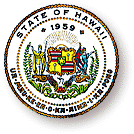
DOE principals try
to navigate new terrainThe schools chief tells them that
14 percent of ninth-graders flunk
Edwin Koyama, the soft-spoken budget director for Hawaii's public schools, took a good look at himself in the mirror yesterday and did something he hadn't done for 30 years.
He shaved off his mustache.
"I have taken that symbolic first step in our transformation," he cracked to a ballroom of several hundred principals and vice principals a few hours later at the Hilton Hawaiian Village. "We need to have the courage and strength to do things differently."
The laughter came as a welcome outlet for educators gathered at a Department of Education conference to grapple with changes headed to their campuses -- from mandates to improve student test scores to new budgetary responsibilities.
Schools Superintendent Patricia Hamamoto highlighted some distressing data, noting that 57 percent of third-graders are not proficient readers and 14 percent of students flunk ninth grade. Then she urged her administrators to tackle the problem one student at a time.
"Do you, your teachers and your support staff know each of these at-risk or at-promise students by name and educational history?" she asked. "For every Jason, Jennifer, Sione or Keala, can you identify what's holding him back? What has been tried? What seems to be working for her? What else can you do?"
She asked them to work toward making all students proficient by helping improve reading results by 10 percent next year. At the elementary level, that translates into each school, on average, having at least five more third-graders and five more fifth-graders scoring proficient or better on their reading exams, she noted. On the secondary level, where schools are larger, the number is 20 10th-graders.
"Is this doable?" she asked. "I'm convinced it is."
Hamamoto cited the example of Kamalii Elementary School in Kihei, Maui, where the fraction of students whose reading skills match their grade level has jumped in the last five years to three-quarters from only one-third. Part of Kamalii's success comes from the STAR software program that regularly diagnoses a student's strengths and weaknesses, and offers techniques to address them. The school aligns instruction to students' abilities and gives extra time to those who need it.
The conference, "Transforming Education for Student Achievement," featured a keynote address by futurist Ed Barlow, who challenged schools to make education relevant for students in a high-tech world and to teach foreign languages. Workshops examined new legislation that will give principals more budget autonomy and require them to collaborate with parents and staff, all while facing federal sanctions if students do not measure up.
"I am going to be working much harder. I am going to be working much longer and under more stress," said Roosevelt High School Principal Dennis Hokama.
"All of these huge changes are taking place," said Eileen Hirota, principal of Ewa Beach Elementary. "We have to really rethink what our students need to learn. We have to learn budgeting. We have to be open and flexible."
"Some people are going to be rethinking their retirement," she added with a giggle.
Also at yesterday's conference, the Hawaii Schools Federal Credit Union and its business partners gave Hawaii's principals of the year free use of a car and insurance. Pflueger Honda provided a Honda Accord for Hirota, the elementary principal of the year; Tony Nissan provided a Nissan Altima to Roger Kim, of Mililani Middle School; and Cutter Pontiac Buick GMC gave a Buick Century to Gail Awakuni, of Campbell High School.
State Department of Education
